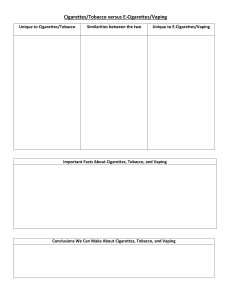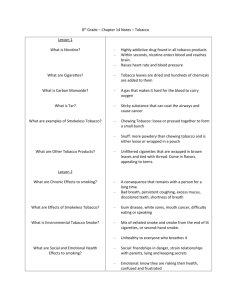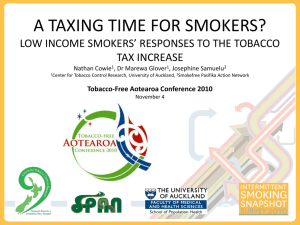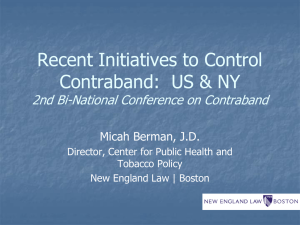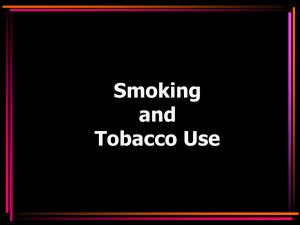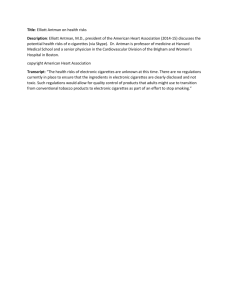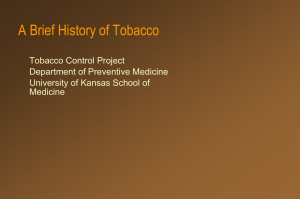Three Main Categories of Drugs
advertisement
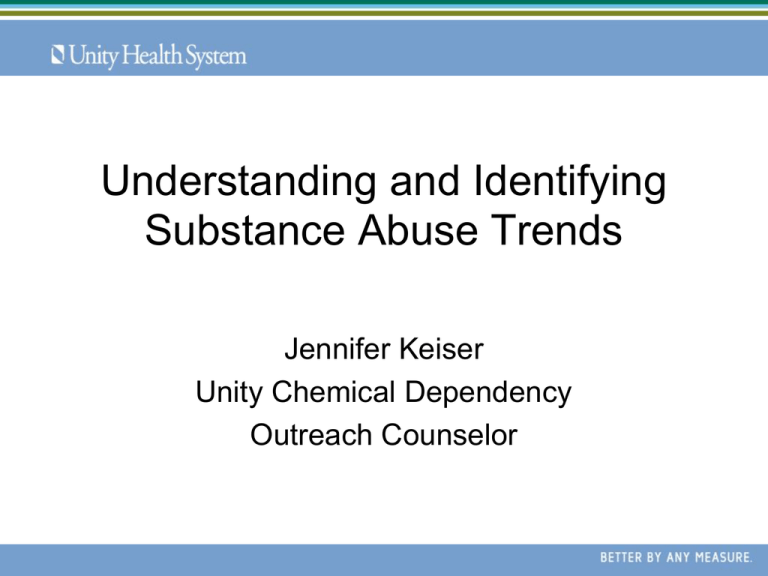
Understanding and Identifying Substance Abuse Trends Jennifer Keiser Unity Chemical Dependency Outreach Counselor What are the trends? • • • • Cigarettes Smokeless tobacco Electronic cigarettes Marijuana • Statistics obtained from the Monitoring the Future Survey 2013 Survey results. Cigarettes • *Cigarette smoking is the leading cause of preventable disease and mortality in the United States, and is usually initiated in adolescents. Cigarettes • Smoking peaked in 1996 for 8th and 10th graders • Began a steady decline thereafter • Smoking initiation by 8th graders declined 1996- 49% 2013- 15% Smokeless Tobacco • Snuff – • finely ground tobacco • Usually sold in tins, loose or in packets • Chew – • leafy form of tobacco • Usually sold in pouches • Snus • New variation • Dissolvable tobacco - Smokeless Tobacco 30 day prevalence rates: • 8th graders Peak in 1994 (7.7%), reached low 2013 (2.8%) • 10th graders Peak in 1994 (10.5%) 2004 (4.9%) 2013 (6.4%) • 12th graders Peak in 1995 (12.2%) 2006 (6.1%) 2013 (8.1%) Electronic Cigarettes • Introduced to the United States in 2007 • Tobacco free product • Are vaporizers – Instead of burning tobacco the mechanism heats up a liquid. It turns to a vapor which is inhaled or “vaped” • Promoted as a way to quit regular cigarettes • Promoted as the safer alternative to cigarettes Electronic Cigarettes Are they safe? • No Quality Control – Lack of disclosure of all the ingredients used, as well as the lack of/validity of health and safety claims of the manufacturers – 2009- FDA found some cartridges of liquid nicotine contained traces of diethylene glycol (toxic chemical found in antifreeze) – FDA testing has found the actual amount of nicotine may not match what the label states and nicotine free cartridges still contain a low dose – Some devices release metals during use, as well as other impurities known to be toxic and/or carcinogenic • Liquid nicotine can be lethal – Call to poison control centers regarding e-cig nicotineinfused liquids rose sharply every month between September 2009 and February 2014, from 1 call to as many as 215 per month – 0.3% to 41.7% of all emergency calls – 51.1% of those calls involved accidental poisoning of kids under age 5 (source: CDC) • Health effects – – – – – E-cig users experience diminished lung function Airway resistance Cellular changes Inflammation Undetermined effects Electronic Cigarettes Are they helping people quit? • “Despite claims that e-cigarettes are helping people quit smoking, we found that e-cigarettes were associated with more, not less, cigarette smoking among adolescents” • “E-cigarettes are likely to be gateway devices for nicotine addiction among youth” –Lauren Dutra, a postdoctoral fellow at UCSF Center for Tobacco Control and Research • Study of 40,000 youth found that e-cig use among middle and high school students doubled between 2011 and 2012 ( 3.1%-6.5%) Are they helping people quit? Marijuana Marijuana is the most common illicit drug in the United States. After a period of decline in last decade, its use has increased among young people since 2007 1960’s to today = 3x THC Genetically modified plant • Perception of risk decreases=use increases Ear Wax Hash Ear wax Hash • • • • • • • • Name from appearance, not origin! Yellow-green waxy material Nicknames - Dabs, honey oil, butter Made with aerosol butane and resin of leaves & buds of female plant How to videos on youtube -recipe Can include up to 90% THC Highly hallucinogenic Reports lasting up to 3 days Can you tell the difference? What Parents Can Do • Create a safe, supportive environment to discuss the risks of tobacco, drug and alcohol use. • Use everyday “teachable moments” as conversation starters. • Connect with teens to find out what they know about drugs and alcohol and how they feel about the pressures they face. • Communicate expectations clearly and what the consequences of use will be. • Get to know your teen’s friends. • Monitor your teen’s whereabouts and online activity. • Encourage community involvement and productive activities. • Have family meals. • Educate yourself on current trends of substance use. • Ask for help and support. Contact Information: Jennifer Keiser Unity Outreach Counselor 585-353-2517 jkeiser@unityhealth.org At McQuaid on Wednesdays and Thursdays Thank you!
